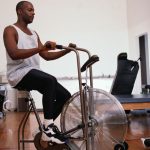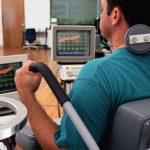
Whether you’re mountain biking, kicking a soccer ball with friends, or just sprinting down the street to catch a bus, your quadriceps are hard at work. The quads are the large muscles that run down the fronts of your thighs. The stronger they are, the less strain each movement will exert on your knees. Lunges and squats will keep these muscles in tip-top shape. The basic squat involves a motion similar to sitting down in a chair. Stand straight, feet shoulder-width apart, toes forward. Keeping good posture, lower your hips until your thighs are parallel to the floor. You might have to work up to this over time, going a little deeper each session. Hold the position for two seconds before returning to the start position. As you get stronger, try the sumo squat. Start with your feet wider than your shoulders with your toes pointed out. Push your hips back and bend your knees, but no more than 90 degrees — your back will lean forward for support. After a few seconds, contract your glutes and slowly stand up. For lunges, start with feet shoulder-width apart. Step forward with your right foot, then lower your left knee almost to the floor as you make a right angle with your right thigh and calf. Bring your left foot up to meet the right and then… read on >





























-300x200.jpg)







-300x169.jpg)
